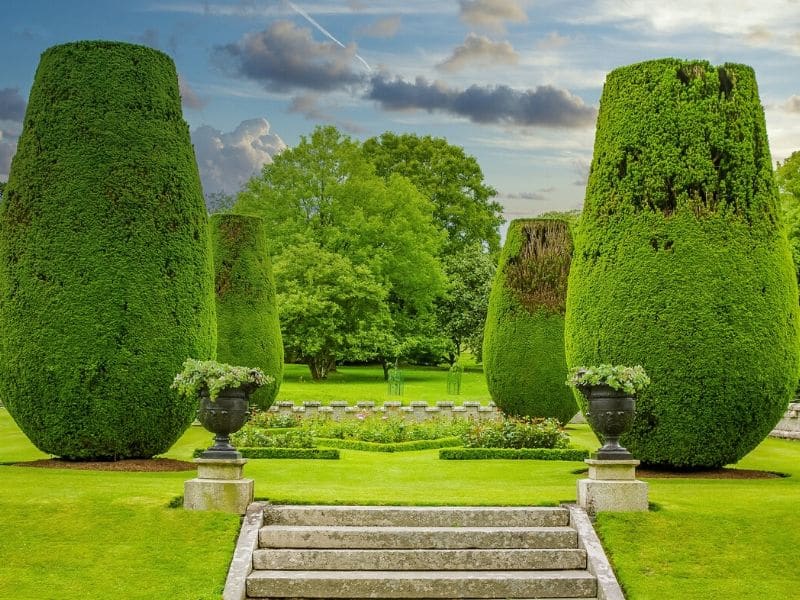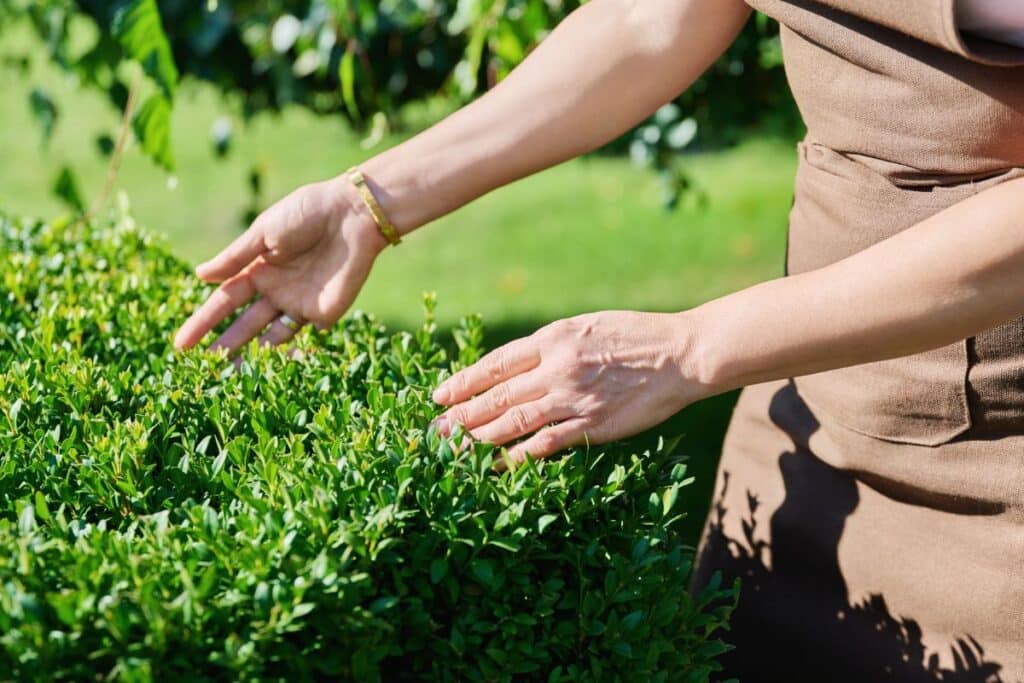Boxwood shrubs are popular for their versatility and wide range of shapes. But if you want your boxwoods to remain healthy, it’s important to prune them regularly.
Pruning is one of the must-learn skills when it comes to boxwood shrub care. Here’s what you need to know about when and how to prune your boxwood shrubs.
Reasons to Prune Boxwood
Here are some reasons to consider trimming boxwood bushes on the reg – or at least, why you should consider an annual pruning.
Give It Some Shape and a More Defined Appearance
Pruning boxwoods allows you to give your shrub a desired shape as well as control its size. This is especially important if you want to create an ornamental hedge or other decorative feature in your garden.
Downsizing an Overgrown Boxwood
If your boxwood has become an unruly and overgrown shrub, it may need to be pruned back severely in order to restore its former shape and size.
To Remove Old Winter Color or Burned Tips
Winter weather can damage the appearance of a boxwood’s foliage, resulting in discolored tips or dead patches. Other diseases can cause boxwood yellowing. Pruning is one way to remove these unsightly blemishes and restore your shrub’s natural color and vibrancy.
To Prevent Disease
Boxwoods can be prone to certain fungal diseases such as Volutella blight and phytophthora root rot if they are allowed to become too dense or overcrowded with foliage.
Regularly removing old growth from the center of the bush opens up air circulation within the plant, which helps prevent disease from taking hold in your shrubbery.
Doing this can also help keep other boxwood companions healthy as well.

Tips on How to Trim Boxwoods
Here are some tips for pruning that will help you get the most out of your boxwoods.
Create Fun Geometric Shapes
Pruning is not just about getting rid of dead or diseased branches or maintaining size – it can also be used to create fun shapes with your boxwood shrub. You can use pruning shears or hedge trimmers to create geometric shapes like squares and cubes, or freeform shapes like spirals or curves that add interest and texture to your landscape.
Use Hand Shears or a Hedge Trimmer
When pruning a boxwood, it’s important to use the right tools for the job. Hand shears are great for small tasks, while a hedge trimmer is more effective if you need to remove large branches or reshape the entire bush in one go.
Sanitize Your Tools to Prevent Spreading Disease
Pruning tools can spread disease from plant to plant if they aren’t properly sanitized between uses. Make sure you clean your pruning tools with alcohol after each use so that you don’t accidentally spread any infections from one plant to another.
Prune Larger Shoots if Allowing Light in is a Goal
If you want light and air circulation around your boxwoods, consider pruning larger shoots off at an angle rather than simply snipping them off at their base. This will help ensure that light is able to penetrate deep into the center of the bush, which is important for healthy growth and development over time.
Remove Any Dead, Diseased, or Overgrown Sections of the Bush
It’s important to regularly inspect your boxwoods for any dead, diseased, or overgrown sections that may require removal. Removing these sections promptly will help prevent further damage from spreading throughout the rest of the shrub.
When is the Best Time to Prune Boxwood Shrubs
Established boxwood shrubs requiring little or no pruning but will benefit from an early spring trim to shape canopies, thin out the plant, and remove any stray branches. Late winter/early spring is typically the best time for pruning.
The timing of this pruning also helps reduce stress on the plants, since there is less risk of damage from cold temperatures. It’s important to note that some boxwood varieties may not need to be pruned each year, so check with a local nursery or garden center before trimming them unnecessarily.
If you’re pruning for aesthetics and not general growth, know that pruning boxwood shrubs can help to maintain an attractive, manicured look. While some gardeners prune these plants in late spring after the spring growth pattern, others wait until mid-summer or early fall.
This allows for growth that still has the chance of maturation before the chill of winter sets in.
Can Boxwoods Be Cut Back Hard?
While boxwoods are generally quite hardy plants that can handle being pruned, there are certain do’s and don’ts to consider before you get started.
When shaping boxwood hedges, it’s important not to cut too far down into the center of the shrub as this can cause permanent damage. Instead, always make sure that you leave some interior foliage intact while shaping the outer parts of the bush. Keep in mind that boxwood shrubs can take multiple years to reach their full size and shape—so patience is definitely key!
Avoid using any harsh chemicals on your boxwood shrubs as this could damage their foliage in the long run. And lastly, never trim off more than one-third of a single branch as this can also cause irreversible damage or even death of the entire plant!
When Can You Not Trim Boxwoods?
It’s important to avoid trimming boxwood shrubs during late summer or early fall when new green growth has already begun.
At this point in their growth cycle, they are more susceptible to diseases such as blight and root rot due to environmental stressors such as hot weather and drought conditions. Trimming at this time can create an unnatural shape which could lead to an unbalanced look in your landscape design.
Finally, it’s never recommended that you trim boxwood shrubs during extremely cold temperatures or after a hard freeze has occurred in your area. Doing so increases the risk of plant damage due to extreme cold temperatures and can potentially kill off parts of the plant if left unchecked over time.
FAQs
What month do you prune boxwoods?
Boxwoods are typically pruned in late winter or early spring, before new growth begins. This timing allows the plant to recover and put out new growth during the growing season.
Can you trim boxwoods way back?
While boxwoods can tolerate heavy pruning, it’s generally best to avoid trimming them back drastically all at once, especially if the plant is mature. Gradual and selective pruning is preferred to maintain the plant’s shape and health.
What boxwoods don’t need to be trimmed?
Some boxwood varieties, such as dwarf or slow-growing cultivars, may require less frequent trimming due to their naturally compact and tidy growth habits. These varieties may not need to be trimmed as often as larger or faster-growing types.
How far can I cut back boxwood?
Boxwoods can be cut back significantly if necessary, but it’s essential to avoid removing more than one-third of the plant’s foliage at a time. Severe pruning can stress the plant and may take longer to recover.
Does trimming boxwoods make them grow faster?
While trimming boxwoods can help maintain their shape and appearance, it doesn’t necessarily make them grow faster. Boxwoods have a moderate growth rate, and regular pruning helps promote dense, healthy growth rather than speeding up overall growth.
Final Thoughts
Pruning your boxwood shrubs can seem intimidating at first — but with a little practice and patience, you’ll soon be an expert!
Just remember that timing is key when pruning; late winter or early spring is ideal for major pruning jobs while summer or fall should only be used for light trimming (and never remove more than one-third of the foliage).
With regular maintenance and proper technique, you’ll have a beautiful and healthy boxwood in no time!
Pruning is also recommended for many shrubs and plants that are similar to boxwood to keep your garden nice and neat.
See more: How to bring boxwoods back to life
*image by Valerii_Honcharuk/depositphotos







